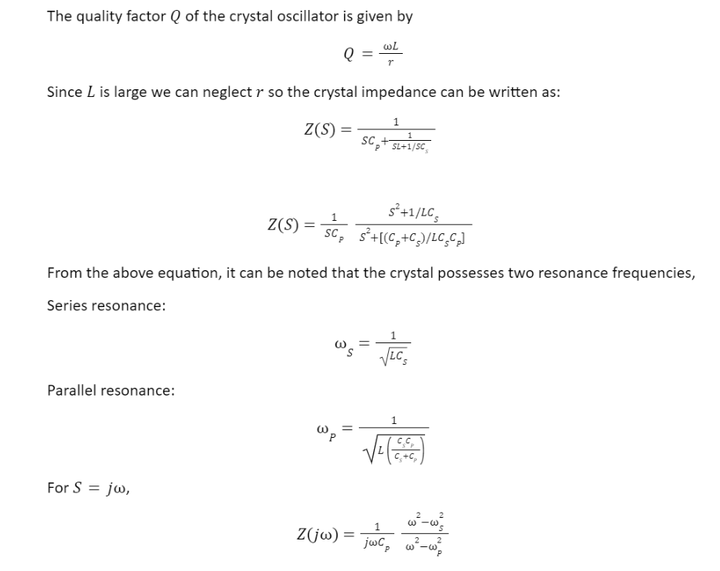- Home/
- GATE ELECTRONICS/
- GATE EC/
- Article
Crystal Oscillator – Principle, Working, Pros & Cons
By BYJU'S Exam Prep
Updated on: September 25th, 2023

The crystal oscillator provides a stable clock signal. Resistance, capacitance, and inductance values in RC and LC oscillators are sensitive to temperature, impacting frequency. This issue can be resolved with the use of piezoelectric crystals in oscillators. Such oscillators are termed Crystal oscillators.
The Piezoelectric effect is a fundamental principle of crystal oscillators. Piezoelectric crystals like Quartz, Rochelle salt, etc., exhibit electromechanical resonance properties, so these crystals are used in the crystal oscillator. In this article, get the overview and working of a crystal oscillator, the Piezoelectric effect, and its advantages.
Table of content
What is Crystal Oscillator?
A crystal oscillator is an oscillator that uses a piezoelectric crystal as a frequency-determining element. Quartz is the most common type of piezoelectric crystal used. Crystal oscillators are used to provide a high load capacitance.
These oscillators are stable high-frequency oscillators as the frequency is unaltered due to the changes in transistor parameters caused by temperature drift. This also leads to a very high-Quality factor in crystal oscillators.
Basic Principle of Crystal Oscillator
The basic principle of a crystal oscillator is the Piezoelectric effect. The piezoelectric crystals are used to exhibit a piezoelectric effect.
Piezoelectric Effect
The crystal demonstrates the phenomenon whereby a potential difference develops across the opposing sides of the crystal when changing mechanical stress is applied across one of its faces. Also, mechanical stress is created along the other faces when a potential difference is applied across one of the faces. The Piezoelectric Effect is the term given to this phenomenon.
A piezoelectric crystal mechanically vibrates when it is exposed to the appropriate alternating voltage. The greatest vibration occurs at the crystal’s natural resonant frequency, determined by the physical dimensions and the way the crystal is cut.
Piezoelectric crystals, such as Rochelle salt, quartz, and tourmaline, are crystalline substances that show the piezoelectric effect. Due to its low cost and easy availability in nature, quartz is the most used piezoelectric crystal.
Equivalent Circuit of Piezoelectric Crystals
The resonance properties of piezoelectric crystals are characterized by a large inductance L, a very small series capacitance CS, and a series resistance r when the crystal vibrates. It can also be characterized as a parallel capacitance CP when the crystal is not oscillating. The capacitor CP is the electrostatic capacitance between the two parallel plates of the crystal.

Since CP » CS, these two resonance frequencies are very close, as shown below. Also, the series resonance is much more dominant than parallel resonance. So, the natural frequency of the piezoelectric crystals can be approximated as:
ω0 ≈ ωs = 1/√(LCS)
The crystal oscillator’s reactance is inductive over the frequency band between ωs and ωp. ∴ These piezoelectric crystals can be used to replace the inductors present in the Colpitts oscillator.
Crystal Oscillator Circuit (Pierce Crystal Oscillator)
Various configurations exist of the crystal oscillator circuits, including the Clap crystal oscillator, the Colpitts crystal oscillator, and the Crystal controlled tuned collector oscillator. The most often used oscillator is the CMOS pierce crystal oscillator.
The above circuit is based on the Colpitts configuration. Resistor Rf provides a dc operating point in the high gain region of the voltage transfer characteristics of the CMOS inverter.
Working of Crystal Oscillator
The crystal controls the oscillation frequency in this basic circuit and runs at its series resonant frequency, providing a low impedance connection from the output to the input. At resonance, there is a 180° phase shift, which causes positive feedback.
The resistance, R1, determines the amount of feedback and crystal drive. Because a Pierce Oscillator is easy to implement, it is used in digital clocks, watches, and timers. The crystal’s series resonant frequency controls the oscillation frequency of the circuit and is given by:
ω0 = 1/√(LCS)
f0 = 1/[2π√(LCS)]
It should be noted that the circuit’s operating frequency, which is maintained constant by the crystal, is unaffected by changes in supply voltage, transistor device characteristics, etc.
Advantages and Disadvantages of Crystal Oscillator
There are several advantages of crystal oscillators. Some of them are:
- They are extremely stable irrespective of the temperature variations and device parameters.
- The Quality factor (Q) of the oscillator is very high.
- Since a crystal mainly vibrates along one axis, just one phase predominates. A crystal oscillator can have extremely low phase noise because of this.
The disadvantage of a Crystal Oscillator is that the oscillation frequency is fixed in this type of oscillator.


